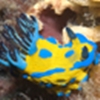General Description
Body shape slug-like with gill structures visible as a single cluster on back of the animal. Pattern includes shades or colours of yellow, orange, red, white and/or purple. Sometimes confused with Dendrodoris aurea, but that species is larger, has parallel sides, is more convex in shape, and is softer to touch. Animal up to 4 cm long.
Biology
This is a very common nudibranch species. There are many other species world-wide of dendrodoridid nudibranchs (family Dendrodorididae), most living in shallow water. They feed external to the body by discharging enzymes onto sponges and the resulting fluids are sucked in through the pharynx.
Habitat
Intertidal and shallow waters, often in association with a thin slimy encrusting sponge under rocks, to depth of 22 m.
Reefs
Sponge gardens
Coastal shores
Distribution guide
Southern and eastern Australia.
Species Group
Nudibranchs and allies › Nudibranchs
Depth
Shore (0-1 m)
Shallow (1-30 m)
Water Column
Max Size
4 cm
Diet
Carnivore
Commercial Species
No
Global Dispersal
Native to Australia
Species Code
MoV 4793
Identify
Conservation Status
- DSE Advisory List : Not listed
- EPBC Act 1999 : Not listed
- IUCN Red List : Not listed





